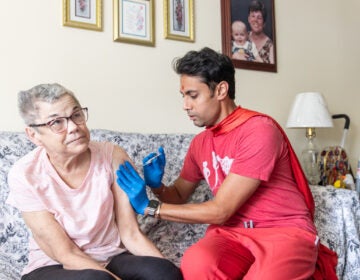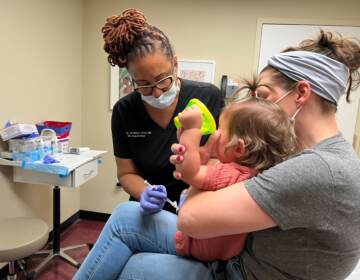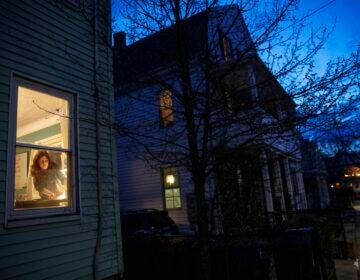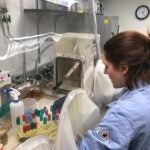If the person you live with has COVID-19, here’s what to do
For many people, COVID-19 has only mild symptoms. In these cases, there’s a good chance the sick person might be able to convalesce at home.
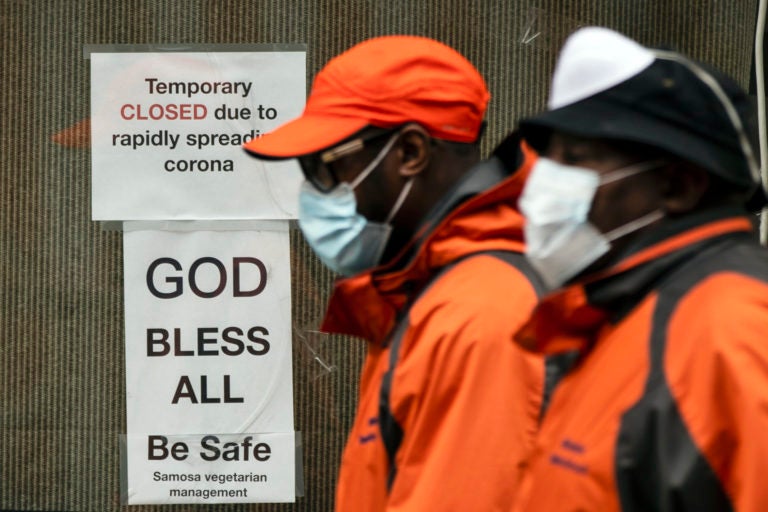
Pedestrians in protective face mask walk past a closed business in Philadelphia, Friday, March 20, 2020. (Matt Rourke/AP Photo)
Austin Kilaru and Katie Auriemma have a 5-month-old son. They’re splitting child care these days because they’re practicing social distancing, don’t want to expose their parents — on whom they rely part of the week — and they have stopped using their nanny. Like many parents, they’re trying to come up with a plan: What will they do if one of them gets sick?
There’s one big difference between this couple and others. Both are doctors: Kilaru is an emergency physician with the University of Pennsylvania, and Auriemma is an ICU physician. Planning for if one of them gets sick is no small feat.
“Overall, we have no perfect solution,” Kilaru said Tuesday.
“We don’t really know how long this thing will go on,” he added. “In our particular family, we made the decision not to split up: one, because one of us might be called in to work in the hospital, and then, two, this could go on for months. We just made a decision for our family, we didn’t want to be apart for a long period of time.”
Kilaru said that, fortunately, children don’t typically get as sick from coronavirus. “But it is possible for them to get sick. I say this to caution parents and families to really take it seriously.”
What can you do if you live with a COVID-19 positive person?
For one thing, don’t panic. COVID-19 is still a mild disease for many people, and there’s a good chance the sick person with you might be able to convalesce at home. As of March 16, the Centers for Disease Control and Prevention reported, only 12% of patients needed to be hospitalized.
Even so, there are steps you should take to protect yourself and others.
If you live with someone who tests positive for COVID-19, consider your house a microcosm of what’s going on in the world as a whole. You want to minimize spread, limit contact, and try to ensure that, best case, no one else contracts the virus and, worst case, if others are going to get sick, it doesn’t happen all at the same time.
About face masks
People have been discouraged from wearing masks to save them for health care workers and the sick. On some level, this still holds. N95 masks are crucial to health care workers who risk their own health at work every day.
Kilaru said they are the best chance he has of not getting sick. “The most essential measure is having enough, and the right, personal protection equipment in the hospital,” he noted. If you do wear a mask, try not to touch it, and change it once a day or as frequently as you are able to.
In this strange, toilet paper-scarce world, having one mask, let alone several, might not seem realistic. If you can’t get a mask, in extreme circumstances the CDC says you can use a scarf or a bandana.
The idea of masks is to limit transmission, so also try to stay at least six feet away and keep practicing social distancing. Any mask will help, you likely don’t need an N95 unless a medical professional tells you to use one. Masks are not the most important thing here.
“The most important things are hand-washing, making sure you’re cleaning down any surfaces like doorknobs. I do think that if someone’s actively sick — coughing — having [them] wear a mask is probably a good idea” said Kilaru.
Talk to your doctor about the best option for you and your family. More instructions can be found at the Philadelphia Department of Public Health website and through the CDC. As with all things medical, consult a health professional if you are unsure.
In fact, if you live with someone with COVID-19, consult a medical professional, period.
Once you’ve donned your makeshift bandana mask, there are three aims: limit, contain and care.
Limit the possible exposures
In-person game nights and impromptu house parties aren’t allowed anyway, but do not invite anyone new into your house. Nominate one caregiver for the person who is sick. Everyone living in the same house will likely be asked to self-quarantine. That doesn’t mean you’re sick too, it just means you might get sick. You’ll be cleared after 14 days with no symptoms.
For the caregiver, don’t kiss or swap bodily fluids. Don’t share towels or toothbrushes. If you have a choice of who will be the primary caretaker, try to pick someone who isn’t older, high risk or pregnant, per the CDC’s guidance.
When possible, the person who is sick should stay in one room and have a separate bathroom. Obviously, this isn’t always possible (looking at you, Philadelphia rowhouses), so in that case, try to keep sick and non-sick people separate and clean aggressively.
This is the plan for Kilaru and his wife, but he acknowledged it isn’t ideal.
“If one of us gets sick, we’ll try … separate bedrooms, but in a small Philadelphia home with a single air-conditioning unit and close proximity, it may be very difficult to prevent the spread,” he said.
Try to contain the virus to just one person
Wash your hands and keep your home as clean as possible. This is huge, Kilaru said.
“The biggest thing that people can do that are not in health care is washing their hands, staying socially distant, and washing down surfaces,” he said.
Scrub your hands with warm soapy water after any contact with the sick person for a full 20 seconds. Feel free to use hand sanitizer as well, but soap and water is the first-line defense. Try to clean surfaces frequently, in bathrooms especially. Also wipe down high traffic surfaces, like doorknobs or countertops. If you’re wondering about disinfectants, here are your options: bleach, soap and water, 70% alcohol, and disinfectants registered with the Environmental Protection Agency.
For bleach, the CDC suggests five tablespoons per gallon of water. Do not mix bleach with other cleaners. If you use a disinfectant, clean with soap and water, then follow the instructions on your disinfectant of choice.
If you have gloves, now would be a good time to wear them, although you cannot reuse gloves or wash them.
For laundry, try to wear gloves when handling the sick person’s laundry. If you don’t have gloves, try to avoid touching the laundry — maybe have your patient put it in a plastic bag; you’ll then empty the laundry into the washing machine and throw the bag away. Wash clothes in the hottest possible water allowed by the care label and dry them completely. If washing isn’t an option, you can use an iron to generate hot steam. The CDC says to shoot for at least 167 degrees Fahrenheit.
Kilaru said he and Auriemma are very careful to limit any contamination between work and home.
“We change clothes at the hospital, wash our hands a million times, and leave all of our clothes, and then change again when we get home, leaving our clothes in a plastic garbage bag. I don’t take my cellphone to work, I don’t take anything to work that I’ll bring back into the house. I’m basically stripping down when I walk in the door and running upstairs and taking a shower.”
If you aren’t a health care worker, you don’t have to go that far, but the basic idea applies: Be mindful what you bring into and out of the sick person’s room.
The care itself: Hydration, over-the-counter meds
Most cases of COVID-19 are mild. As of March 19, the Food and Drug Administration had yet to substantiate reports about a risk with ibuprofen (Motrin, Advil), so any over-the-counter anti-inflammatory like that or acetaminophen (Tylenol) is probably OK. Read the label and talk to your doctor.
Try to think of creative solutions. We’ve all been using technology to communicate with people outside our homes, so there’s no reason not to use it to communicate with people inside the house. In the event this is not a mild case of COVID-19, watch for shortness of breath, blueness, tiredness, trouble breathing, or chest pain. If you’re worried, call your doctor. If you don’t have a doctor, consider calling the local health department or a teledoctor, or go to the emergency room. If you are bringing a COVID-19 patient to a hospital, call ahead. The hope is these are decisions you can make with the help of a health care provider.
According to the CDC, most people will improve within a week. Patients are considered cured after two negative tests in a row, or if they have no fever, have generally improved, and have gone seven days since the onset of symptoms. Don’t be afraid to reach out for help. By staying home, and staying safe, you’re helping everyone so ask for the help you need.
Kilaru agreed, saying, “Just because one person in the house has the virus doesn’t necessarily mean everyone else will get sick.”
WHYY is your source for fact-based, in-depth journalism and information. As a nonprofit organization, we rely on financial support from readers like you. Please give today.


![CoronavirusPandemic_1024x512[1]](https://whyy.org/wp-content/uploads/2020/03/CoronavirusPandemic_1024x5121-300x150.jpg)
